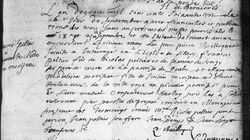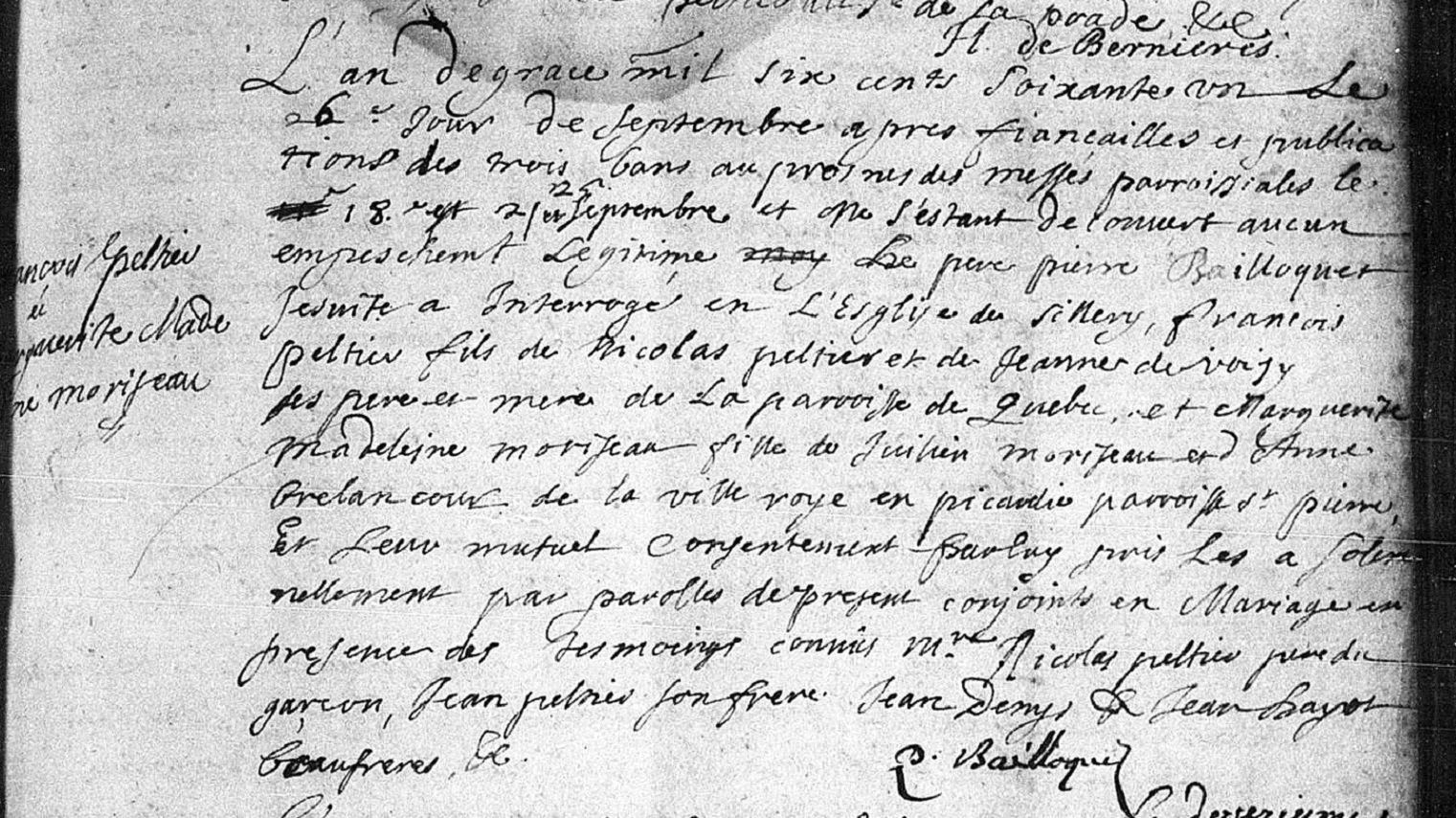FRANÇOIS PELLETIER dit ANTAYA, c.1635-c.1688
Second known son of Nicolas Peltier and Jeanne de Voisy, François Pelletier dit Antaya was born about 1635, probably in France, and grew up in the French colonial establishments at Québec City and at Sillery. An experienced trapper and trader, he was also later "seigneur" (lord) of a "seigneurie" (fief).
François Pelletier's "dit name" — Antaya — appears in the archives of New France for the first time in a Becquet contract dated 22 August 1667, written as "Nontayé." The origins of this name are not known but may have been Amerindian.
François Pelletier dit Antaya was an adept "coureur de bois," knowledgeable of First Peoples' languages and skilled in their ways of the forest. As a fur trader, François dealt with indigenous tribes from as far east as the Saguenay-Lac Saint-Jean region to as far west as the Great Lakes.
In November 1659, François accompanied Jesuit priest Charles Albanel on a journey from Québec to the mission-trading post at Tadoussac. While the exact details of their voyage are not known, according to the "Journal des Jésuites," on 24 April 1660, at Québec, there "arrived from Tadoussac Father Albanel, who, before his departure from Tadoussac, had married a Frenchman named François Pelletier with a Christian Indian woman [named Dorothée], without publication of bans or notice given to the parents, the bishop or the governor, which caused a great stir." François and Dorothée's marriage produced no children and lasted only a year: In April 1661, she died at the Hôtel-Dieu (hospital) at Québec, "after having received all the sacraments of the Church," and her body was buried in the cellar beneath the hospital.
Later that same year (1661), following his participation in a summer expedition to Hudson Bay, François returned to Sillery and on 26 September 1661 married Marguerite Morisseau. She was a native of the city of Roye, in the northern French province of Picardy. They went on to have ten children.
About 1668, François and family moved some 120 miles upriver to the Seigneurie de Saurel (today the city of Sorel-Tracy), found at the mouth of the Richelieu River, northeast of Montréal. He had received a concession of land there from Seigneur Pierre de Saurel, former captain of the noted Carignan-Salières Regiment, sent to New France in 1665 to quell the Iroquois hostilities.
François' connection to Captain de Saurel dated to at least July 1666, when François was among the three hundred French and Indians whom Saurel led on an expedition against the Iroquois who had killed two officers from his regiment and captured four or five others. Likewise, it was François who returned to Québec ahead of the expedition to announce the prisoners' liberation.
On 22 October 1675, François and Marguerite purchased a tract of land sitting on the north shore of the Saint Lawrence River across from the Seigneurie de Saurel. It measured 1 ½ miles along the River by 3 miles inland, and included Haystack Island (l'Île-aux-Foins) as well as the islets situated between the Island and terra firma.
During the latter third of the seventeenth century, François and Marguerite participated actively in the fur trade. Even after François' death about 1688, Marguerite continued to hire and send trappers west to the Great Lakes to trade with the Indians there. Indeed, one of the last mentions of François in the archives of New France is an Adhémar contract dated 1 August 1688: Marguerite Morisseau had to hire two men to travel west to collect and return with furs and pelts belonging to her late husband. In the contract, Marguerite was identified as "the widow of Fran. Pelletier Ontaya of Orvilliers."
In the following century, many descendants of François Pelletier dit Antaya and Marguerite Morisseau remained in the Saint Lawrence River Valley, but not all of them. Some ventured west to the Great Lakes, while others settled along the Upper Mississippi River Valley, where they married with the native peoples there and founded families of their own, living as trappers, traders, soldiers, interpreters and guides. Wherever they lived, their descendants perpetuated the name Pelletier; others, Antaya.
FRANÇOIS PELLETIER dit ANTAYA, c.1635-c.1688
Second known son of Nicolas Peltier and Jeanne de Voisy, François Pelletier dit Antaya was born about 1635, probably in France, and grew up in the French colonial establishments at Québec City and at Sillery. An experienced trapper and trader, he was also later "seigneur" (lord) of a "seigneurie" (fief).
François Pelletier's "dit name" — Antaya — appears in the archives of New France for the first time in a Becquet contract dated 22 August 1667, written as "Nontayé." The origins of this name are not known but may have been Amerindian.
François Pelletier dit Antaya was an adept "coureur de bois," knowledgeable of First Peoples' languages and skilled in their ways of the forest. As a fur trader, François dealt with indigenous tribes from as far east as the Saguenay-Lac Saint-Jean region to as far west as the Great Lakes.
In November 1659, François accompanied Jesuit priest Charles Albanel on a journey from Québec to the mission-trading post at Tadoussac. While the exact details of their voyage are not known, according to the "Journal des Jésuites," on 24 April 1660, at Québec, there "arrived from Tadoussac Father Albanel, who, before his departure from Tadoussac, had married a Frenchman named François Pelletier with a Christian Indian woman [named Dorothée], without publication of bans or notice given to the parents, the bishop or the governor, which caused a great stir." François and Dorothée's marriage produced no children and lasted only a year: In April 1661, she died at the Hôtel-Dieu (hospital) at Québec, "after having received all the sacraments of the Church," and her body was buried in the cellar beneath the hospital.
Later that same year (1661), following his participation in a summer expedition to Hudson Bay, François returned to Sillery and on 26 September 1661 married Marguerite Morisseau. She was a native of the city of Roye, in the northern French province of Picardy. They went on to have ten children.
About 1668, François and family moved some 120 miles upriver to the Seigneurie de Saurel (today the city of Sorel-Tracy), found at the mouth of the Richelieu River, northeast of Montréal. He had received a concession of land there from Seigneur Pierre de Saurel, former captain of the noted Carignan-Salières Regiment, sent to New France in 1665 to quell the Iroquois hostilities.
François' connection to Captain de Saurel dated to at least July 1666, when François was among the three hundred French and Indians whom Saurel led on an expedition against the Iroquois who had killed two officers from his regiment and captured four or five others. Likewise, it was François who returned to Québec ahead of the expedition to announce the prisoners' liberation.
On 22 October 1675, François and Marguerite purchased a tract of land sitting on the north shore of the Saint Lawrence River across from the Seigneurie de Saurel. It measured 1 ½ miles along the River by 3 miles inland, and included Haystack Island (l'Île-aux-Foins) as well as the islets situated between the Island and terra firma.
During the latter third of the seventeenth century, François and Marguerite participated actively in the fur trade. Even after François' death about 1688, Marguerite continued to hire and send trappers west to the Great Lakes to trade with the Indians there. Indeed, one of the last mentions of François in the archives of New France is an Adhémar contract dated 1 August 1688: Marguerite Morisseau had to hire two men to travel west to collect and return with furs and pelts belonging to her late husband. In the contract, Marguerite was identified as "the widow of Fran. Pelletier Ontaya of Orvilliers."
In the following century, many descendants of François Pelletier dit Antaya and Marguerite Morisseau remained in the Saint Lawrence River Valley, but not all of them. Some ventured west to the Great Lakes, while others settled along the Upper Mississippi River Valley, where they married with the native peoples there and founded families of their own, living as trappers, traders, soldiers, interpreters and guides. Wherever they lived, their descendants perpetuated the name Pelletier; others, Antaya.
Gravesite Details
The oldest cemetery in Sorel, used from about 1670 to 1702, and located at the present-day corner of Rue du Fort and Rue de la Reine. No trace or remnant of the original cemetery exists today.
Family Members
Advertisement
Records on Ancestry
Sponsored by Ancestry
Advertisement










